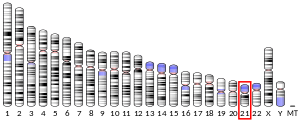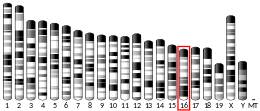Chromosome 21 open reading frame 91
Chromosome 21 open reading frame 91 is a protein that in humans is encoded by the C21orf91 gene. [5]
| C21orf91 | |||||||||||||||||||||||||
|---|---|---|---|---|---|---|---|---|---|---|---|---|---|---|---|---|---|---|---|---|---|---|---|---|---|
| Identifiers | |||||||||||||||||||||||||
| Aliases | C21orf91, C21orf14, C21orf38, CSSG1, EURL, YG81, chromosome 21 open reading frame 91 | ||||||||||||||||||||||||
| External IDs | MGI: 1196400 HomoloGene: 9696 GeneCards: C21orf91 | ||||||||||||||||||||||||
| |||||||||||||||||||||||||
| |||||||||||||||||||||||||
| Orthologs | |||||||||||||||||||||||||
| Species | Human | Mouse | |||||||||||||||||||||||
| Entrez | |||||||||||||||||||||||||
| Ensembl | |||||||||||||||||||||||||
| UniProt | |||||||||||||||||||||||||
| RefSeq (mRNA) | |||||||||||||||||||||||||
| RefSeq (protein) | |||||||||||||||||||||||||
| Location (UCSC) | Chr 21: 17.79 – 17.82 Mb | Chr 16: 78.54 – 78.58 Mb | |||||||||||||||||||||||
| PubMed search | [3] | [4] | |||||||||||||||||||||||
| Wikidata | |||||||||||||||||||||||||
| |||||||||||||||||||||||||
EURL is a structural protein gene that is encoded within the human chromosome 21.[6][7] It stands for gene Expressed in Undifferentiated Retina and Lens and was first found in chick embryos. It is also known as C21orf 91 (Chromosome 21 open reading frame 91)[8]. This gene produces many molecules; among them is a protein that influences neural development. This protein-coding region helps to code for neural development in humans and is strongly associated with neural progenitor cells as well as neurons associated with the cerebral cortex of the brain.[6]
Thus, being on chromosome 21, defects linked to this gene are heavily correlated to Down Syndrome. There are some knockout models regarding other genes involved in Down Syndrome, but there seems to be primary interest in a knockdown model for this specific gene. It is believed that because there is three codes of this gene rather than two, that the higher concentration of this molecule has the implications leading to Down Syndrome. Scientists are currently working on a hypothesis that the dosage of the EURL protein is directly correlated to neural development in the embryo and how an altered dosage leads to the neural deficits seen in Down Syndrome.[6]
References
- GRCh38: Ensembl release 89: ENSG00000154642 - Ensembl, May 2017
- GRCm38: Ensembl release 89: ENSMUSG00000022864 - Ensembl, May 2017
- "Human PubMed Reference:". National Center for Biotechnology Information, U.S. National Library of Medicine.
- "Mouse PubMed Reference:". National Center for Biotechnology Information, U.S. National Library of Medicine.
- "Entrez Gene: Chromosome 21 open reading frame 91". Retrieved 2017-06-01.
- Li SS, Qu Z, Haas M, Ngo L, Heo YJ, Kang HJ, et al. (July 2016). "The HSA21 gene EURL/C21ORF91 controls neurogenesis within the cerebral cortex and is implicated in the pathogenesis of Down Syndrome". Scientific Reports. 6: 29514. Bibcode:2016NatSR...629514L. doi:10.1038/srep29514. PMC 4941730. PMID 27404227.
- Kirk IK, Weinhold N, Belling K, Skakkebæk NE, Jensen TS, Leffers H, et al. (March 2017). "Chromosome-wise Protein Interaction Patterns and Their Impact on Functional Implications of Large-Scale Genomic Aberrations". Cell Systems. 4 (3): 357–364.e3. doi:10.1016/j.cels.2017.01.001. PMID 28215527. Retrieved 2019-04-15.
- "C21orf91". Retrieved 14 April 2019.
Further reading
- Godbout R, Andison R, Katyal S, Bisgrove DA (July 2003). "Isolation of a novel cDNA enriched in the undifferentiated chick retina and lens". Developmental Dynamics. 227 (3): 409–15. doi:10.1002/dvdy.10310. PMID 12815627.
External links
- "Tissue expression of C21orf91 - Summary". the Human Protein Atlas. Retrieved 14 April 2019.



